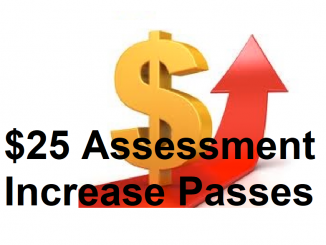
In this Article we are going to dive deep into the world of Golf in Big Canoe. We will begin by looking at the very misleading picture painted by the Chambers Report. We will discover the hidden costs of Golf to the community, and provide property owners with the real LOSSES (not profit) that Golf takes from the community’s financial bottom line. We will explore the national trends in Golf and Golf Communities. Lastly, we will open up the minds of the community to alternative paths forward in regards to the Golf Program within Big Canoe. To set your minds at ease…. I will not be calling for the elimination of the Golf program, and will even be calling for an enormous influx of capital to repair and bring the courses up to “Par”.
Part 1: The Chambers Report
According to the Chambers Report Summary (Pg 2), 65% of Respondents think that “Golf Course Enhancements” are a low priority. Of course, that is NOT how the Report presents it, which is as “an enhancement that Big Canoe property owners feel *is* top priority” — with a percentage score of 35%. I guess that when ALL of your top five projects get less than 50% support – the best way to spin it, is to pretend that being in the “Top 5” of things most people overwhelmingly do not support – actually implies “top priority”.
The manipulation doesn’t stop there. Even that 35% number is in serious question. Below is a quote from the introduction of the Chambers Report (Pg 3):
- 1,858 Surveys were returned from 1,350 unique lot numbers resulting in 40% of the overall Property Owners respondingto the survey. (out of 4,645 total property owners)
On Page 34 of the Report are two important data points about the Golf portion of the survey:
- Of the 1858 respondents, 42% responded they had utilized the golf facilities in the past year. (1858 x 42% = 780)
- 46% of those said they were Golf Members. (780 x 46% = 359 Golf Members, which represents 19.3% of all survey respondents).
On Page 11 of the March 2019 Measures and Tracking Report, it was reported that the Entire Community had:
- a total of 389 Golf Members.
That means that “Golf Club Members” had a 92% Chambers Survey Response Rate (359 / 389 = 0.92), compared to an overall Community Members Response rate of 40%. Chambers says that the margin of error on the overall report is 2.2%, but it clearly fails to factor in an extremely overweighted segment of the community – which is the “Country Club Golf crowd” that utilizes the Clubhouse and Golf Amenities at a much higher rate than the average Property Owner. Golf Members (389) represent only 8.4% of the total Property Owners, but they represented 19.3% of the Survey Respondents. We don’t track the “Casual Players” so this is just a hypothesis – but I am willing to bet that segment is severely over-represented as well in the Survey.
The takeaway is that even the exceptionally low “35%” support for “Golf Course Enhancements” is likely inflated due to a survey population that is heavily over-weighted towards Golfers. Conversely, the 65% of people that think “Golf Course Enhancements” are a LOW PRIORITY, is probably an even higher percentage. It was a nice try at spinning support for “Golf Course Enhancements”, but in the end they cannot hide the fact that there is extremely low community support for any expensive Golf Project. I think it is safe to deduct that there is actually substantial Opposition to the plan.
Part 2: The Real Financial Picture of Big Canoe Golf
The following financial overview is based upon the last 5 years of Annual Financial Reports submitted to the property owners, excerpted here: 2018 ; 2017 ; 2016 ; 2015 ; 2014. As reported in these POA Financials, the following are the annual Profit & Loss numbers for Total Golf Net Income.
$185,253 (2018 Profit); $219,885 (2017 Profit); $252,028 (2016 Profit); $106,911 (2015 Profit); $133,746 (2014 Profit)
- Over the entire 5 Years that is a total of $897,823 in PROFIT for Overall Golf Net Income.
- As an annual Average over the 5 Years, that equates to $179,564 in PROFIT Per Year!
THE PROBLEM with that pretty picture is that it is completely fabricated, manipulated and spun to make it look like we are making money on Golf, but the reality is that Golf is hemorrhaging money losses. Every year we pump enormous “Capital Expenditures” into the Golf program – which are neither counted as Golf Maintenance nor Operating Costs. They actually ARE those things – but in a trick of accounting magic, those costs get counted as Depreciated Cap Ex spending, and not reported in profit/loss. Let’s look at the real numbers, which include the $2,334,216 of Annual Golf-Related Capital Expenditures that we’ve taken directly from the annual financial statements.
Below is what we’ve actually spent on Golf over the past 5 years:
2018: +$185,253 (Reported Profit) – 248,632 (Cap Ex) = -$63,379 Annual LOSS
2017: +$219,885 (Reported Profit) – 201,604 (Cap Ex) = +$18,281 Annual Profit
2016: +$252,028 (Reported Profit) – 1,082,354 (Cap Ex) = -$830,326 Annual LOSS
2015: +$106,911 (Reported Profit) – 192,983 (Cap Ex) = -$86,072 Annual LOSS
2014: +$133,746 (Reported Profit) – 608,643 (Cap Ex) = -$474,897 Annual LOSS
- REAL Average Over 5 Years: -$287,278 LOSS PER YEAR
- REAL Total Over 5 Years: -$1,436,393 LOSS
The above numbers are the REAL amounts of money we have spent on Golf over the past 5 years. If the Golf Program DID NOT EXIST AT ALL – then that is the amount of extra money that we would have in our Bank Account over the 5 years based on the direct savings. So let us be perfectly clear that having a Golf Program in Big Canoe is NOT making us any profit – unless presented as a CapEx Depreciated Schedule.
HERE IS THE TRUTH: Even if you are able to depreciate something for Accounting Records – you still spent it.
Looking forward, the RUMOR NUMBER that is most commonly heard around the community is that they are going to combine Chambers and the Bergin Golf reports to promote a $4-$5,000,000 Golf Course redesign. If true, that looks like another $1,000,000+/- per year in the LOSS column for the next 5 years. PLUS INTEREST on any loan we take out!
Looking back at a previous section of the Article, let us remember that Golf Club Members only equal 8.4% of overall property owners. Granted that another 15-20% of the community may occassionally play a pickup round of golf as “non-members”, it is also important to note that the Chambers Report showed that on average these types of “occassional players” only average a round of golf every 6 weeks (9 rounds per year).
This seems a bit of a lopsided budget – with the majority of property owners supporting the very expensive hobby of a small minority. It begs the question…. Are we utilizing what we have efficiently?
Part 3: Use of Existing Courses
This is a short section. The bottom line here is that we have (3) nine hole courses, for a total of 27 holes of golf. The courses are in decent shape, but not in great shape. According to most peeople I have spoken to, they are often running a course rotation, in which much of the time there are only (2) courses open, while the 3rd cycles into unused maintenance status. My point here is that we have already proven we can run on an 18 Hole Course operations plan, and it can handle the existing traffic.
The question here is…. would it be more efficient, more maintenance and operationally cost effective, and would it serve our needs, if we went to an 18 Hole Course Model (2 Nine-Holes)? We’ll explore this trend in the next section.
Part 4: A Global Trend of Downsizing Golf Courses, and an Aging Demographic
Golf is declining on a National and Global basis. The trend is towards less overall use, and shorter play (increased 9 hole participation). Over the past decade, many courses have shut down completely, or switched to 9 hole play focus.
This trend started during the Recession. I am not going to bore you with references. Google <golf recession> and you can read the articles till you are blind. The recession was just the trigger to the decline in the sport however. A secondary metric took hold even as the recession lifted…. and that was the failure of Golf to grab the attention of the next generation, the Millenials. The younger generations nowadays are busy and distracted – mostly by technology, to which they are addicted. To put it bluntly, they don’t have time for, and they get easily bored with, Golf. It is a sport on the decline, and the vast majority of its participants are aging, and trending towards lower participation rates.
Another important consideration…. we are likely heading for another recession. It may be a year, maybe two, but it is coming and everyone with a brain knows it. It is simply a historical pattern of boom-bust cycles, and not only are we due for one any time now – the global debt situation is indicating that it could be another big one. If and when we get another recession – Rental Housing Stays, Golf Rounds, and Clubhouse Covers will all drop. Visitor traffic to Big Canoe will slow to a crawl. This isn’t doom and gloom by the way…. this is simply a historically proven fact of life in Big Canoe, and in similar communities that have a large rental or 2nd home components with resort-like amenities. Even if it is a little recession, it will have an impact – especially on discretionary activities like Golf. And as the previous recession showed, we’ll likely see another continuation of the decline in Golf participation rates.
So the question…. “Is this a good time to sink substantial long-term investment into a declining leisure industry?” is a rational question, and it deserves better than some manipulated Survey to guide our thought and decision processes.
Summary: The Issue of Golf in Big Canoe deserves to be seriously discussed, and the following considered.
- Golf is on the decline. Even within the community participation rates are declining.
- Golf is costing the community a ton of money.
- Another large infusion of capital is going to burden all property owners with another big assessment increase.
- We have LOTS of other looming issues that we may need to finance in the community as well, and the infamous 2016 Land Deal has already locked up most of our finance for years to come. Tapping our Reserve Loan, or even adding to that is going to completely hamstring us financially if anything unexpected comes up.
- Reducing our Course Footprint from 27 Holes to 18 Holes would save us a lot of maintenance cost. We could then put in a hefty $500 – 600K into the (2) remaining nine-holes and get them up to “Par” and have One Really Great 18 Hole Golf Course!
- The community already handles existing Golf traffic much of the time with just 18 holes in operation.
- In 2007 (before the ongoing recession initiated decline began) a study of 16,009 U.S. Golf Courses (See Pg 25) showed that 18 Hole Courses actually make up almost 2/3’s of the Nation’s Golf Courses, coming in at 62+%. Nine Hole Courses came in 2nd with 28+% of the total pie. 27+ Hole Courses actually took up a very small percentage of the pie, coming in at only 9+%. Moving to 18 Holes would actually be a trend to normal.
- The land on a discontinued nine-hole could be held back for future amenity use. A few ideas are:
- A huge, multi-sectioned Dog Park that you could drive right up into and conveniently just park your car and hop out.
- Can you imagine the proposed walkout Lower Level Clubhouse Pavillion – bordering a new Bocce & Croquet Complex on the existing #9 Fairway and Green? It would add life to the Clubhouse area and bring in a steady stream of Food and Beverage consumers. These sorts of “Casual Social Sports” are clearly on the rise in Big Canoe amongst new members, younger members, and also the older retirees. Everybody seems to be trending towards these Lower Cost, Socially Interactive, Smaller Footprint, Higher Food & Beverage Consumption types of pastimes! Let’s Get Ahead Of The Curve!
- A Zipline area on the far side of Lake Disharoon.
- I’ve always thought that a PuttPutt Center somewhere in Big Canoe would be a fantastic draw for visiting GrandKids! There would now be plenty of space.
- Maybe down the road Big Canoe could offer Community Garden Plots or Orchard areas, or actually take a couple of fairways to create that “Serenbe” style community that the Developer used as marketing bait so many times during the early 2000’s to lure many of us here. For 1/8 of the rumoured Golf Infusion – Big Canoe could have an operational farm paid for years, with a really neat permanent Community Farmers Market / Produce Store. And AgriTourism is Big Business and a Big Draw!
- YES, some golf course homeowers may pitch a fit, but if we were to eliminate say, the Creek Course, there would actually be very few Golf Course Lots “lost” – and honestly I think that Property Values overall would go up as people started realizing that Big Canoe was taking the step of becoming fiscally responsible. If some of the Amenity focus was redirected to other popular areas, there may even be an increase in value – and we are NOT ELIMINATING GOLF!
- Or maybe whichever course is chosen – simply lies fallow, gets cut less often, and let it trend back to nature with Walking / Bike paths – saving ourselves several $Million Dollars in the process. Property Owners have years to decide what to do. My summary point here is that We have Options!
I’m not proposing we do anything with unused course land right now. Property Owners just need to discuss whether any of this makes sense as a viable option. Honestly the past few Boards and the current GM have gotten us into a real financial mess, and we simply have to deal with the fiscal crossroad we are at. Maybe this isn’t the right decision to make – shutting down nine-holes, but maybe neither is sinking a lot of new money and redesign into the course. I don’t know – but it should be discussed with greater sincerity than the bogus (and clearly non-supportive) numbers we paid $125,000 for in the Chambers Report.
This is worth pointing out again…. that less than 10% of the population of Big Canoe Property Owners even plays enough Golf that they would miss nine of the existing holes. Sure, some may love the concept of that extra diversity, and they may act entitled, spoiled and make a fuss…. but the bottom line is that the vast majority of Property Owers here do NOT play Golf, and mostly do not care about Golf. We are NOT talking about “Killing Golf”, just scaling it down to an economically viable option that is more in line with the national average and trend – even infusing $500 – $600K into improving an existing 18 Hole subset of what we have. We could probably make that up in a few years on the maintenance and operational savings we’d get from moving from 27 to 18 holes.
What we cannot do is continue to ignore the reality of the facts, or avoid the future economic consequences of continuing to “burn money” on a dying industry that only serves a minority of the community – especially not with the possibility of a recession looming.
The MAJORITY of the Property Owners need to start demanding dialogue – open & honest dialogue on the serious economic issues and directional options facing this wonderful community.
It is not the end of the world, nor treasonous heresy, to suggest that we change course to a future that has a SLIGHTLY lower emphasis on Golf. It’s called life / change / adapting to new circumstances. It happens. Embrace new ideas and new possibilities. Let’s start thinking about what WE WANT for the future of this community.
And don’t be afraid to speak up! Unfortunately, the minority will speak up once they read this, and I already shudder just thinking of the next wave of toxic hate coming my way… but you know what, you get used to it, and there is a certain joyful feeling that comes from speaking your mind, and doing your best to look at creative and solutions oriented alternatives. It’s fueled by HOPE.
Find your hope for the future vision of Big Canoe, and speak up for it.
Good luck. Peace,
– david / publisher
Focus On Big Canoe, GA is the Only Investigative Reporting Newspaper Serving the Community of Big Canoe, GA. It was founded in 2018 by 20 year resident, David Hopkins. We do investigations, research, analysis, editorials, and we provide comunity residents a portal to openly share “letters to the editor / board / or community”; even to create and distribute their own “citizen journalist” sectionals. The opportunity to share your Well Considered, Well Researched, Well Thought Out, and Well Written Ideas with the community now exists. Our primary standards are old, simple concepts in Jouranlism: Tell the Truth / Expose the Secrets / Expand the Boundaries of Thought.
RESOURCES:
Website: www.BigCanoe.org
Join Our Mailing List: http://bigcanoe.themountainsvoice.com/eblast-signup/
Facebook Marketing Page: https://www.facebook.com/focusonbigcanoega/
Facebook Discussion Group: https://www.facebook.com/groups/FocusonBigCanoeGA/
Newspaper Contact & Tipline Info: http://bigcanoe.themountainsvoice.com/tipline/




Be the first to comment